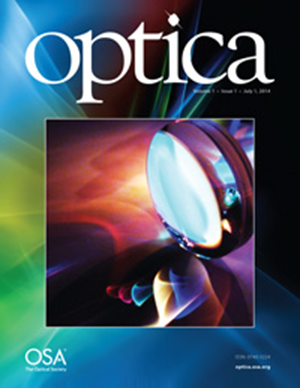Hyperspectral in-memory computing with optical frequency combs and programmable optical memories
IF 8.5
1区 物理与天体物理
Q1 OPTICS
引用次数: 0
Abstract
The rapid rise of machine learning drives demand for extensive matrix-vector multiplication operations, thereby challenging the capacities of traditional von Neumann computing systems. Researchers explore alternatives, such as in-memory computing architecture, to find energy-efficient solutions. In particular, there is renewed interest in optical computing systems, which could potentially handle matrix-vector multiplication in a more energy-efficient way. Despite promising initial results, developing high-throughput optical computing systems to rival electronic hardware remains a challenge. Here, we propose and demonstrate a hyperspectral in-memory computing architecture, which simultaneously utilizes space and frequency multiplexing, using optical frequency combs and programmable optical memories. Our carefully designed three-dimensional opto-electronic computing system offers remarkable parallelism, programmability, and scalability, overcoming typical limitations of optical computing. We have experimentally demonstrated highly parallel, single-shot multiply-accumulate operations with precision exceeding 4 bits in both matrix-vector and matrix-matrix multiplications, suggesting the system’s potential for a wide variety of deep learning and optimization tasks. Our approach presents a realistic pathway to scale beyond peta operations per second, a major stride towards high-throughput, energy-efficient optical computing.利用光频率梳和可编程光学存储器进行高光谱内存计算
机器学习的迅速崛起推动了对大量矩阵-向量乘法运算的需求,从而对传统冯-诺依曼计算系统的能力提出了挑战。研究人员探索内存计算架构等替代方案,以找到高能效的解决方案。特别是,人们对光学计算系统重新产生了兴趣,因为它有可能以更节能的方式处理矩阵矢量乘法运算。尽管取得了令人鼓舞的初步成果,但开发可与电子硬件媲美的高吞吐量光学计算系统仍是一项挑战。在这里,我们提出并展示了一种高光谱内存计算架构,它利用光频率梳和可编程光存储器,同时利用空间和频率复用技术。我们精心设计的三维光电子计算系统具有显著的并行性、可编程性和可扩展性,克服了光学计算的典型限制。我们在实验中演示了高度并行的单次乘积运算,矩阵-向量和矩阵-矩阵乘积的精度都超过了4比特,这表明该系统具有完成各种深度学习和优化任务的潜力。我们的方法为实现每秒千万亿次以上的运算提供了现实途径,是向高吞吐量、高能效光学计算迈出的重要一步。
本文章由计算机程序翻译,如有差异,请以英文原文为准。
求助全文
约1分钟内获得全文
求助全文
来源期刊

Optica
OPTICS-
CiteScore
19.70
自引率
2.90%
发文量
191
审稿时长
2 months
期刊介绍:
Optica is an open access, online-only journal published monthly by Optica Publishing Group. It is dedicated to the rapid dissemination of high-impact peer-reviewed research in the field of optics and photonics. The journal provides a forum for theoretical or experimental, fundamental or applied research to be swiftly accessed by the international community. Optica is abstracted and indexed in Chemical Abstracts Service, Current Contents/Physical, Chemical & Earth Sciences, and Science Citation Index Expanded.
 求助内容:
求助内容: 应助结果提醒方式:
应助结果提醒方式:


